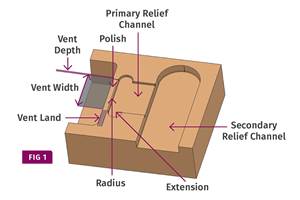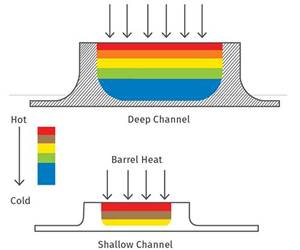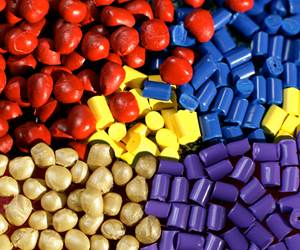Use a Process Assessment to Determine the Benefits of Screw-Design Modification
This type of analysis analysis will provide the converter with a clear picture of whether changes to the screw could provide economic gains through increased rate, yield, and quality.
Many extrusion processors wait too long to change out worn screws. And while delaying the purchase of a new screw, they are operating with a disadvantaged process and decreasing the profitability of the line. A new screw will restore the economic advantages of the line, such as higher rates, improved mixing and lower discharge temperatures.
I encourage converters to perform a process assessment to study the operation of the line and determine if minor screw-design modifications can enable higher rates and lower discharge temperatures, creating value to the converter, especially if the line is sold out.
Fact is, most commercial single-screw extruders in operation today are not optimized for maximum rate and performance. Instead, they are operating at lower rates and lower qualities, thereby reducing the profitability of the plant. Operating at the maximum rate will minimize the fixed costs per unit of product by spreading these costs over more product. Product quality is a little more difficult to quantify because different markets have different tolerances for defects, especially for polyethylene film products. A defect-free film product, however, may enable the film to be sold into a premium market, producing additional value to the converter.

A process assessment by an extrusion expert is typically the first step of the optimization process. The assessment would provide the converter with a clear picture of whether changes to the screw could provide economic gains through increased rate, yield and quality. The assessment should determine the rate-limiting operation for the existing process. Moreover, if the rate limitation is removed, the assessor should be able to estimate the maximum rate obtainable and the new functionality that limits the rate of the new process.
Operating at the maximum rate will minimize the fixed costs per unit of product by spreading these costs over more product.
For a continuous process like single-screw extrusion, the major costs for manufacturing include raw material costs, capital investment and financial costs, as well as conversion and maintenance costs. Raw material costs include the cost of the resin, fillers, additives, blowing agents and color masterbatches, to name a few. Capital investment includes the purchase and installation of the equipment and the infrastructure. Costs related to the capital investment for a production line can be very important, especially for new installations where the depreciation of the equipment is significant.
Conversion and maintenance costs are associated with the operation of the extrusion process and the cost of maintaining the line in operating condition. Conversion and maintenance costs include labor costs, utility costs, yield loss costs, scrap recycling, waste treatment costs, taxes and insurance, maintenance and supply costs, and overhead costs.
Case Study
As an example, a converter was running a blown film line using a 3.5-inch diameter smooth-bore, single-screw extruder. The PE resin was a blend of materials with a melt index (MI) of 1.0 dg/min (2.16 kg, 190°C). With a new screw, the line was running at 130 kg/hr at a screw speed of 52 rpm and producing an extrudate with a temperature of 241°C. The line was sold out. The high extrudate temperature limited the maximum rate to 130 kg/hr. That is, at higher rates the extrudate temperature increased and the bubble became unstable and off-specification product resulted.
After several years of operation, however, the screw showed a significant level of flight wear, and the rate decreased to 117 kg/hr at a screw speed of 50 rpm. Thus, the specific rate decreased from 2.50 kg/(hr rpm) when the screw was new to 2.34 kg/(hr rpm) when it was worn. The specific rate is simply the rate divided by the screw speed. The PE was discharging from the extruder at a temperature of about 241°C. Because this line was sold out, the high screw wear reduced the capacity of the line by about 79,000 kg/yr, and thus this film was not available for sale.
A new screw with the incumbent design could be built to restore the performance of the line, or an optimized design could be installed at the same cost. A process assessment was made for the line, and it was determined that an optimized screw could be built that would decrease the extrudate temperature. A lower extrudate temperature would likely enable a rate increase beyond 130 kg/hr. The decision was to design and purchase an optimized screw at a cost of $8,400.

FIG 1 Overall product film costs for the worn, restored and optimized screws.
The screw was built and installed into the extruder. The optimized screw was able to operate at a maximum rate of 154 kg/hr at a screw speed of 52 rpm and an extrudate temperature of 221°C. Thus, the extrudate temperature was decreased by 20°C and the rate was increased by 18%. Bubble cooling was determined to be the rate-limiting operation with the optimized screw. The extrudate temperature decreased because the specific rate of the screw was increased from 2.50 kg/(hr rpm) for the incumbent design to 2.96 kg/(hr rpm) for the optimized screw.
A cost model was constructed to evaluate the economic impact of the three processes: the worn screw, a restored (incumbent design) screw and the optimized screw. The key inputs and assumptions of the cost model are summarized in Table 1. The line was operational 24 hours a day for 252 days a year. There was a 5% material yield loss due to startups, shutdowns and nonstandard operations. Trimmed edges from the bubble were recycled to the feed hopper. The equipment was fully depreciated.

FIG 2 Comparison of the conversion costs of the film product for the worn screw, the incumbent screw and the optimized screw design.
The overall film product costs in units of $/kg using the worn, restored and the optimized screw designs were estimated using the cost model. A comparison is shown in Figure 1. By increasing the rate by 18% by installing the optimized screw instead of a restored screw, the overall cost was reduced by 3.9% from $2.28/kg to $2.19/kg. It was solely due to the reduction in conversion cost as the rate increased, as shown in Figure 2. As shown by Figure 2, the largest cost reduction is the cost of labor. As a comparison, if the worn screw would have been replaced by a restored screw of the same design, the cost would have been reduced by 3.8% on a kg of product. And if the worn screw was replaced by an optimized one, the cost would be reduced by 7.6%.
The rates, capacity and conversion costs are summarized in Table 2. For an operation time of 6,048 hr/yr, the capacity of the optimized screw was 931,000 kg/yr for an increase of 145,000 kg/yr compared to the restored screw. Because this line is sold out, the extra 145,000 kg/yr provides an economic gain to the ´óĎó´«Ă˝. As shown in the table, the restored screw reduced costs by $71,000/yr and the optimized screw by $168,000/yr.

The payback period for the upfront investment on the optimized screw was also calculated. The payback period did not include the costs associated with shutting the line down and installing the optimized screw. As mentioned previously, the cost of the optimized screw was $8,400. The cost modeling results indicate that the optimized screw reduced the cost of the product by $0.09/kg as compared to the restored screw. Based on the assumption of 6,048 hours of operation time a year and the fact the optimized screw runs at a 154 kg/hr, the payback period of the optimized screw was 25 days.
For most applications, the rate increase will pay for a new screw within a few weeks to months.
The manufacturing cost savings generated by the optimized screw is estimated to be $168,000/yr. If the gross margin is 10%, the total value to the converter is $373,000/yr. Assuming a 30% margin, the annual cost savings and value added is $780,000/yr.
The calculations above assumed that the operation time remains at 252 days a year after installing the optimized screw. In practice, an optimized screw design could also significantly reduce the operational downtime by minimizing gels that potentially cause bubble breaks. If the annual operation time can be increased by up to 20% after installing an optimized screw, the operation time could potentially increase to 300 days a year. At 300 days of operation time and the increased rate, the conversion cost of the process can be reduced to $0.51/kg, and the overall production cost is lowered to $2.13/kg. For this scenario, the cost reduction has a value of $255,000/yr, and the payback time is 14 days.
A capacity increase for a line can occur by an increase in run time or by a rate increase. For lines that are sold out, increasing the line rate can be very lucrative and can delay the installation of costly new equipment. Recent examples of rate improvement by optimizing the screw for PE resins is provided in Table 3. For these applications, new screws were designed with deeper, optimized channels. The optimized channels resulted in higher specific rates, lower discharge temperatures and the mitigation of resin degradation. The lower discharge temperatures enabled the rate of the lines to be increased. For these cases, the rate increases were significant at 18% (this case) to 43%.

For most applications, the rate increase will pay for a new screw within a few weeks to months. Applications using resins other than PE can also benefit from screws optimized for a lower discharge temperature..
About the Authors: Mark A. Spalding is a fellow in Packaging & Specialty Plastics and Hydrocarbons R&D at Dow Inc. in Midland, Michigan. During his 39 years at Dow, he has focused on development, design and troubleshooting of polymer processes, especially in single-screw extrusion. He co-authored with Gregory Campbell. Contact: 989-636-9849; maspalding@dow.com; .
Xiaofei Sun is a research scientist in Packaging & Specialty Plastics and Hydrocarbons R&D at Dow Inc. in Lake Jackson, Texas. Through his 11-year career at Dow, his research has been dedicated to the development of polymer processing technologies, including single-screw extrusion, twin-screw extrusion, injection molding and batch compounding processes. Contact: 608-320-4728; xsun3@dow.com.
Related Content
Back to Basics on Mold Venting (Part 2: Shape, Dimensions, Details)
Here’s how to get the most out of your stationary mold vents.
Read MoreProcess Monitoring or Production Monitoring — Why Not Both?
Molders looking to both monitor an injection molding process effectively and manage production can definitely do both with tools available today, but the question is how best to tackle these twin challenges.
Read MoreThe Importance of Barrel Heat and Melt Temperature
Barrel temperature may impact melting in the case of very small extruders running very slowly. Otherwise, melting is mainly the result of shear heating of the polymer.
Read MoreFundamentals of Polyethylene – Part 6: PE Performance
Don’t assume you know everything there is to know about PE because it’s been around so long. Here is yet another example of how the performance of PE is influenced by molecular weight and density.
Read MoreRead Next
For PLASTICS' CEO Seaholm, NPE to Shine Light on Sustainability Successes
With advocacy, communication and sustainability as three main pillars, Seaholm leads a trade association to NPE that ‘is more active today than we have ever been.’
Read MoreMaking the Circular Economy a Reality
Driven by brand owner demands and new worldwide legislation, the entire supply chain is working toward the shift to circularity, with some evidence the circular economy has already begun.
Read More











